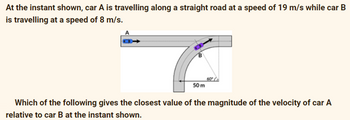
Structural Analysis
6th Edition
ISBN: 9781337630931
Author: KASSIMALI, Aslam.
Publisher: Cengage,
expand_more
expand_more
format_list_bulleted
Question

Transcribed Image Text:At the instant shown, car A is travelling along a straight road at a speed of 19 m/s while car B
is travelling at a speed of 8 m/s.
50 m
60⁰
Which of the following gives the closest value of the magnitude of the velocity of car A
relative to car B at the instant shown.
Expert Solution
This question has been solved!
Explore an expertly crafted, step-by-step solution for a thorough understanding of key concepts.
This is a popular solution
Trending nowThis is a popular solution!
Step by stepSolved in 2 steps

Knowledge Booster
Learn more about
Need a deep-dive on the concept behind this application? Look no further. Learn more about this topic, civil-engineering and related others by exploring similar questions and additional content below.Similar questions
- A particle traveling along the parabolic path y = 0.25x. If x = (2t²) m, wheret is in seconds, determine the magnitude of the %3D particle's acceleration in m/s? when t = 2 s. y-0.25xarrow_forwardA particles moves along a curve whose parametric equation are x = t³ + 2t, y = - 3e-2t and z = 2 sin (5t), where x, y and z show variation of the distance covered by the particles in (cm) with time (t) (in second). The magnitude of the acceleration of the particle (in cm/s²) at t = 0 isarrow_forwardAs a car comes around a bend onto a straight road moving at 80 km/hr the driver suddenly notices another slower car ahead, a distance d = 50 m ahead, moving at 30 km/hr. At this moment, in order to avoid hitting the slow-moving car ahead the driver slows down but takes .25 seconds to react relative to first noticing the car 50 m ahead. Assuming the car decelerates at a constant rate, above what minimum magnitude of the deceleration avoids a rear-end collision? can you solve this with a detailed explanationarrow_forward
- A ship which moves at a steady 22-knot speed (1 knot = 1.852 km/h) executes a turn to port by changing its compass heading at a constant counterclockwise rate. If it requires 59 s to alter course 90°, calculate the magnitude of the acceleration a of the ship during the turn.Answer: a = m/s2arrow_forward18 of 45 Save A particle moves along a curve whose parametric equations are x = t³ + 2t, y = -3e-2t and z = 2 sin (5t), where x, y and z show variations of the distance covered by the particle (in cm) with time t (in s). The magnitude of the acceleration of the particle (in cm/s²) at t = 0 isarrow_forward
arrow_back_ios
arrow_forward_ios
Recommended textbooks for you

 Structural Analysis (10th Edition)Civil EngineeringISBN:9780134610672Author:Russell C. HibbelerPublisher:PEARSON
Structural Analysis (10th Edition)Civil EngineeringISBN:9780134610672Author:Russell C. HibbelerPublisher:PEARSON Principles of Foundation Engineering (MindTap Cou...Civil EngineeringISBN:9781337705028Author:Braja M. Das, Nagaratnam SivakuganPublisher:Cengage Learning
Principles of Foundation Engineering (MindTap Cou...Civil EngineeringISBN:9781337705028Author:Braja M. Das, Nagaratnam SivakuganPublisher:Cengage Learning Fundamentals of Structural AnalysisCivil EngineeringISBN:9780073398006Author:Kenneth M. Leet Emeritus, Chia-Ming Uang, Joel LanningPublisher:McGraw-Hill Education
Fundamentals of Structural AnalysisCivil EngineeringISBN:9780073398006Author:Kenneth M. Leet Emeritus, Chia-Ming Uang, Joel LanningPublisher:McGraw-Hill Education
 Traffic and Highway EngineeringCivil EngineeringISBN:9781305156241Author:Garber, Nicholas J.Publisher:Cengage Learning
Traffic and Highway EngineeringCivil EngineeringISBN:9781305156241Author:Garber, Nicholas J.Publisher:Cengage Learning


Structural Analysis (10th Edition)
Civil Engineering
ISBN:9780134610672
Author:Russell C. Hibbeler
Publisher:PEARSON

Principles of Foundation Engineering (MindTap Cou...
Civil Engineering
ISBN:9781337705028
Author:Braja M. Das, Nagaratnam Sivakugan
Publisher:Cengage Learning

Fundamentals of Structural Analysis
Civil Engineering
ISBN:9780073398006
Author:Kenneth M. Leet Emeritus, Chia-Ming Uang, Joel Lanning
Publisher:McGraw-Hill Education


Traffic and Highway Engineering
Civil Engineering
ISBN:9781305156241
Author:Garber, Nicholas J.
Publisher:Cengage Learning